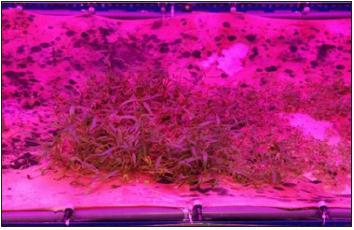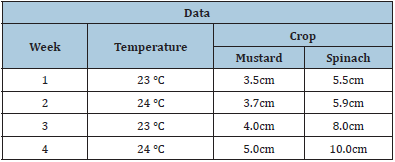- Submissions

Full Text
COJ Electronics & Communications
Investigation on Vegetable Growth Using Aero Farm Technique for Indoor Farming
Kesavan Ulagnathen*, Mohamad Azrul B Baharuddin, Joshua Arapoc, Roszliana Bt Fadzil and Sakila Bt Salamat
Politeknik Sandakan Sabah, Malaysia
*Corresponding author: Kesavan Ulagnathen*, Mohamad Azrul B Baharuddin, Joshua Arapoc, Roszliana Bt Fadzil and Sakila Bt Salamat
Submission: April 23, 2020;Published: March 25, 2021

ISSN 2640-9739Volume2 Issue1
Abstract
Indoor planting or better known as indoor farming has become more widely used method as it is able to provide higher yields throughout the year. Currently most of the developed country facing the shortage of land for agriculture production. In this technique, one of the most important things is the use of artificial light sources to replace the sun at indoor environment. Besides the artificial lights, medium of the soil is replace by a plain towel as a trial run for the growth rate of a vegetable. In this study, LED grow light with three different LED color lights, 5W and a piece of plain white towel were used as a replacement of soil medium. Monitoring process by watering and adding some fertilizers via water to the plant were done. The height or growth of the plant was taken for 4 weeks period and recorded. At the end of the study, it was found there is growth of vegetable, mustard and spinach in the towel. The mustard growth by an average for four weeks around 1.5cm and total spinach growth is around 4.5cm for four-week period. From the studies it shows different LED color lights create an impact on the height growth of a vegetable. This study is useful for researchers that focus on indoor farming using the right artificial light as a source of sunlight and plain cloth as a source of soil in future.
Keywords: In door farming; Aero farm; Led lamp; Grow light; Growth height
Introduction
Agriculture is becoming a popular industry in the current world. Many researchers have
work and publish their work about this industry in various conferences and journals [1-3].
One of the current trends in this field is Aero Farm. Aero Farm is one of the high-tech methods
of cultivation that does not use elements such as soil or sunlight and it reduces the use of
water in less quantity [4]. This is because this technology only applies spraying method in
watering process. Furthermore, this method uses cloth as a substitute for medium soil and
requires Light-Emitting Diode (LED) lighting as a substitute for sunlight to complement the
plant photosynthesis process. By applying this technology, special nutrients or fertilizers are
used directly through plant root system to reduce the use of excessive fertilizer to plants.
Hence, the application of Aero Farm can help farmers or housewives in growing crops in a
small scale both either at home and in any parts of building.
The Aero Farm method can only be used in planting small scale plants such as salad,
mustard or spinach due to humidity condition that can accommodate crop growth. Therefore,
nowadays the Aero Farm method is applicable because it does not require large space and
can overcome the decreased area of agricultural land problem due to development and
urbanization [5,6]. Meanwhile, in New Jersey, people were suffered from food shortage
problem as the food source decreases from time to time. Thus, in order to overcome the
problem of food supply, New Jersey built the Vertical Agricultural Industry in New York to
tackle food supply problem. As a result, the cultivation process that uses this method was
a success and it can produce over 900 tonnes of crops per year by using this technology.
Some studies have shown that the use of this technology can encourage agricultural activities
in urban area which in turn can develop awareness among the public about the benefit of
applying Aero Farm method for future generation. In addition, the Aero Farm method helps
the public to understand high-tech agricultural techniques and also in reducing the land use
in the future [7].
Problem statement
Some people are unable to carry out agricultural activities for
certain purposes. Among the problems faced are as follows:
1. Limited cultivation area for agriculture due to the increase
activities in industrial and housing development.
2. The country’s agricultural sector is still too dependent on
imported products from other countries.
Objective
The goal of this project is to design and build Aero Farm system
so that it could be integrated into agriculture as well as to introduce
it to the community, especially farmers. However, this project
focuses on a small scale. The following are the objectives of this
project:
1. To utilized undeveloped area and old buildings in urban
area.
2. To reduce the dependence on imported goods, especially
agricultural products mainly vegetables.
Scope
Vegetable crops: The Aero Farm system is one of the
innovations made for the purpose of cultivating high quality
vegetable without the use of large space in producing high quality
vegetable cultivation.
The technology of fertigation: Fertigation system is one of the
cultivation technology systems that uses liquid chemical fertilizer.
Nowadays, consumers are very concerned when selecting which
products to use by considering many factors such as issues that
related to health, food and environmental pollution.
Modern technology: The use of the Aero Farm system can help
farmers that interested in expanding their agriculture by taking
steps to overcome future problems especially limited space for
agricultural activities.
Methodology
This project was implemented by following the sequence of steps which is shown in Figure 1 to ensure it was done perfectly according to the objectives of the study. This project was started by conducting a literature review as stated in the diagram whereby all information related to this project was reviewed and collected to provide background information about this project. After that, project materials were gathered, and the project was done by stages. Once the project was completed, it was tested from its ability of producing good quality products without the application of soil [8].
Figure 1: Project Flow Chart.

Findings and data analysis
Throughout the entire implementation of the project, results of the project were collected and analyzed accordingly. The plants in the Aero Farm system were similar to the plants which were planted on the ground and each of them required 16 elements to grow well. In the Aero Farm system, these elements were dissolved in water to enable it to be absorbed by the roots and this solution is called as nutrient solution or fertilizer solution. Normally, the materials are used in the form of mineral salt or liquid. The ratio of the nutrient portion dissolved into the water was referred to determine the exact measurement. If 1 milligram of A+B fertilizer is dissolved in a 1 liter of clean water, the concentration of the solution is read as 1PPM while the clean water that has not been mixed with fertilizer has 0PPM. To ensure excellent growth of crop, PPM value need to be measured frequently by referring to the standard work concentration value which is 1280PPM. Besides that, the experimental test on the durability of the system was also conducted through 2 stages. In the early stage, the cloth used was viewed as too thin which resulted the inability of the plant to survive, and the growth of the plant was affected because the watering process was done once in a day. Meanwhile, in the second stage of the experiment, the problem was fixed by changing the previous cloth to a thick and furry cloth to enable good crops production. In addition, the watering process was done twice daily to increase crop growth as proactive measures and taking necessary steps are imperative to maintain the project running smoothly (Figures 2 & 3) show the results of the study on the growth of vegetables such as spinach and mustard by using a cloth. The reliability and validity of all the data taken and measured is around 90% for this experiment.
Figure 2: The structure and growth of vegetables on a cloth.

Figure 3: The growth of spinach and mustard on a cloth.

Data of vegetables growth
The measured data in this experiment has been captured and presented in Table 1 and Figure 4. It was observed the spinach growth rate was much better than the mustard.
Table 1: Vegetable height by weekly.

Figure 4: Comparison of vegetable growth height.

Conclusion
First and foremost, the preparation process of a project needs to be planned carefully and throughout the entire project, there were various obstacles and problems which led to unsatisfactorily results. Even though this is a trial run project with limited time period, the project is still considered a success by growing a vegetable in a plain cloth without using soil as a medium of farming though the outcome might be slightly beyond expectation. The Aero Farm System project is materialized through the observation from large industries which it has potential and can be beneficial to the community because it does not require large space to implement this project. The objective of the Aero Farm System project is to utilize the undeveloped area and the old buildings in urban area. Besides that, this project can be referred as a solution to mitigate the problem of groundwater contamination and to improve nutrient amount in soil. In conclusion, the project is able to assist the agricultural industry in decreasing use of depleted area of agricultural land due to rapid development and urbanization.
Acknowledgement
We would like to thank personally Agro technology department of Polytechnic Sandakan Sabah for giving us an opportunity to conduct this study. Besides this our personal thanks to Mr Julainus Jiun from General Studies Department Polytechnic Sandakan Sabah for helping us on translation.
References
- Anem M (1970) Anim agro technology.
- Maisurimianti (2011) Pengaruh kosentrasi Pupuk Akar dan Pupuk Daun terhadap Pertumbuhan dan Produksi Bayam (Amaranthus hybridus) dengan Metode Nutrient Film Technique (NFT). Universitas Islam Negeri Syarif Hidayatullah Jakarta.
- Shahimi OI (2015) Tanam salad cara hidroponik.
- Team A (2015) Aerofarm plant scientist make forbes 30 under 30 list for science.
- Trizelia T (2015) Keane karagaman tanaman bertingkat entomopatogen pada rhizosfer berbagai tanaman sayuran.
- Wirayanti A (2013) Implementasi program urban farming pada kelompok sumber trisno alami di kecamatan bulak kota surabaya.
- Ken Utami (2012) Fungsi pengairan.
- Sukiman H (2015) Pemanfaatan mikoriza untuk meningkatkan kualitas bibit pohon dan produktivitas lahan kawasan perkotaan.
© 2020 Kesavan Ulagnathen. This is an open access article distributed under the terms of the Creative Commons Attribution License , which permits unrestricted use, distribution, and build upon your work non-commercially.
 a Creative Commons Attribution 4.0 International License. Based on a work at www.crimsonpublishers.com.
Best viewed in
a Creative Commons Attribution 4.0 International License. Based on a work at www.crimsonpublishers.com.
Best viewed in 







.jpg)






























 Editorial Board Registrations
Editorial Board Registrations Submit your Article
Submit your Article Refer a Friend
Refer a Friend Advertise With Us
Advertise With Us
.jpg)






.jpg)














.bmp)
.jpg)
.png)
.jpg)










.jpg)






.png)

.png)



.png)






